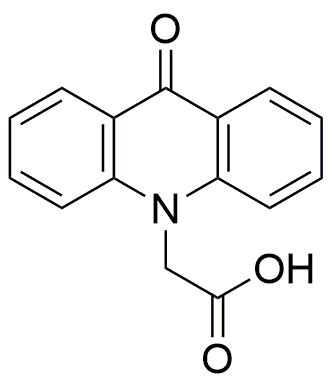9-Oxoacridine-10-acetic acid is widely utilized in research focused on:
- Fluorescent Probes: This compound is used to develop fluorescent probes for biological imaging, allowing researchers to visualize cellular processes in real-time.
- Anticancer Research: It has potential applications in the development of anticancer agents, as it can interact with DNA and inhibit cancer cell proliferation.
- Photodynamic Therapy: The compound can be employed in photodynamic therapy, where it acts as a photosensitizer, generating reactive oxygen species to target and destroy cancerous cells.
- Organic Synthesis: It serves as an intermediate in organic synthesis, facilitating the creation of complex molecules in pharmaceuticals and agrochemicals.
- Analytical Chemistry: This chemical is used in analytical methods for detecting and quantifying biomolecules, enhancing the accuracy of biochemical assays.
General Information
Properties
Safety and Regulations
Applications
9-Oxoacridine-10-acetic acid is widely utilized in research focused on:
- Fluorescent Probes: This compound is used to develop fluorescent probes for biological imaging, allowing researchers to visualize cellular processes in real-time.
- Anticancer Research: It has potential applications in the development of anticancer agents, as it can interact with DNA and inhibit cancer cell proliferation.
- Photodynamic Therapy: The compound can be employed in photodynamic therapy, where it acts as a photosensitizer, generating reactive oxygen species to target and destroy cancerous cells.
- Organic Synthesis: It serves as an intermediate in organic synthesis, facilitating the creation of complex molecules in pharmaceuticals and agrochemicals.
- Analytical Chemistry: This chemical is used in analytical methods for detecting and quantifying biomolecules, enhancing the accuracy of biochemical assays.
Documents
Safety Data Sheets (SDS)
The SDS provides comprehensive safety information on handling, storage, and disposal of the product.
Product Specification (PS)
The PS provides a comprehensive breakdown of the product’s properties, including chemical composition, physical state, purity, and storage requirements. It also details acceptable quality ranges and the product's intended applications.
Certificates of Analysis (COA)
Search for Certificates of Analysis (COA) by entering the products Lot Number. Lot and Batch Numbers can be found on a product’s label following the words ‘Lot’ or ‘Batch’.
Numéro de catalogue
Numéro de lot/série
Certificates Of Origin (COO)
This COO confirms the country where the product was manufactured, and also details the materials and components used in it and whether it is derived from natural, synthetic, or other specific sources. This certificate may be required for customs, trade, and regulatory compliance.
Numéro de catalogue
Numéro de lot/série
Safety Data Sheets (SDS)
The SDS provides comprehensive safety information on handling, storage, and disposal of the product.
DownloadProduct Specification (PS)
The PS provides a comprehensive breakdown of the product’s properties, including chemical composition, physical state, purity, and storage requirements. It also details acceptable quality ranges and the product's intended applications.
DownloadCertificates of Analysis (COA)
Search for Certificates of Analysis (COA) by entering the products Lot Number. Lot and Batch Numbers can be found on a product’s label following the words ‘Lot’ or ‘Batch’.
Numéro de catalogue
Numéro de lot/série
Certificates Of Origin (COO)
This COO confirms the country where the product was manufactured, and also details the materials and components used in it and whether it is derived from natural, synthetic, or other specific sources. This certificate may be required for customs, trade, and regulatory compliance.


